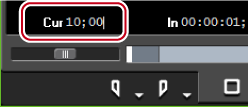EDIUS 7 Online Help
Reference ManualHardware Setup Guide
Installation Manual
User Guide
You can jump to In and Out points on the timeline.

Setting the In and Out Points on the Timeline
 Alternative
AlternativeClick [Marker] on the menu bar, and click [Go to In Point] ([Go to Out Point]).
Right-click the slider on the Recorder, and click [Go to In Point] ([Go to Out Point]).
Right-click the time scale, and click [Go to In Point] ([Go to Out Point]).
Right-click the timeline cursor, and click [Go to In Point] ([Go to Out Point]).
Jumping to the In and Out points on the timeline: [Q]/[W]
You can jump to a specified position on the timeline by entering the numerical values for the timecode at that position.
When “1000” is entered

The timeline cursor moves.


Enter “+” or “−” at the beginning of the number with the numerical keypad, and the timeline cursor will jump forward or backward by the entered number.
This function acquires the timecode of the frame displayed on the Player (or Recorder), and jumps to the position matching the timecode on the timeline (or Player). For example, you can use match frame when switching the video image of an interview to another video image of the same interview which was recorded from a different angle using 2 cameras, to smoothly switch the image cuts without any interruption in motion or sound. Match frame is available even for source video taken from equipment that can be controlled on a deck.
After acquiring the timecode of the clip displayed on the Player, jump to the corresponding position on the timeline clip and display it on the Recorder.
The timeline cursor is jumped to the timeline position matching the timecode of the specified source.

The timeline cursor moves, and the matching frame is displayed on the Recorder.
 Alternative
AlternativeJumping from Player to the timeline: [Ctrl] + [F]

By default, [Match Frame (Player to Recorder)] is not displayed. Before performing the operation, set to display the buttons on the Player.
Clips containing the timecode of the frame currently displayed on the Player can be searched in the bin by the following operation.
Click [Clip] on the menu bar, and click [Search Bin] → [Including Cursor (Player)].
Searching bin (Player TC): [Shift] + [Ctrl] + [F]
Display the matching frame of the source clip at the timeline cursor position on the Player.
Match frame is possible on decks if the source is from a deck, or match frame is possible on files if the source is a file.
The matching frame is displayed on the Player.
 Alternative
AlternativeDisplaying source clip: [Alt] + [F]

When the source currently displayed on the Player is a file, [Match Frame (Recorder to Player)] performs match frame on that file. When the source is from a deck, match frame is performed on the deck.
When the source currently displayed on the Player is a file, [Match Frame (Recorder to Source)] displays the clip currently selecting match frame on the timeline, and performs match frame. When the source is from a deck, match frame is performed on the deck.
You can search clips with timecodes of the timeline clip in the bin by the following operation. The search result folder is created in the folder view of the bin.
Click [Clip] on the menu bar, and click [Search Bin] → [Including Cursor (Recorder)].
Searching clips at the timeline cursor position in the bin: [Shift] + [F]
The clip can be displayed on the Player by clicking and selecting the clip on the timeline and performing the following operation.
Click [Clip] on the menu bar, and click [Show in Player].
Displaying selected clip on the Player: [Shift] + [Y]
In scenes set with a transition, 2 clips overlap each other on the same track. To execute the match frame function on overlapping clips, you can set the clip to acquire the timecode in before or after the clip.
Switch to the gang mode to synchronize the cursor positions or In and Out points of the Player and the timeline.
Using the gang mode before preroll editing is useful in deciding the position where clips are placed on the timeline.
Previewing Cut Switch Points (Preroll Edit (Preview))
Placing Clips while Checking Cut Switch Points (Preroll Edit (Rec))
 Note
NoteSources displayed in the deck mode cannot be synchronized.
Each click switches the mode on and off.
A diagonal line appears on the icon when the mode is off.


By default, [Set Gang Mode] is not displayed. Before performing the operation, set to display the buttons on the Player.

The cursors of the Player and the timeline are synchronized based on the current cursor position. The cursor positions to be synchronized can be changed by the following operation. After unchecking [Cursor] and moving the cursor of the Player or the timeline, check [Cursor] again.

The In (Out) points of the Player and the timeline are synchronized based on the current In (Out) point position. The In (Out) point positions to be synchronized can be changed by the following operation. After unchecking [In] ([Out]) and changing the In (Out) point of the Player or the timeline, check [In] ([Out]) again.